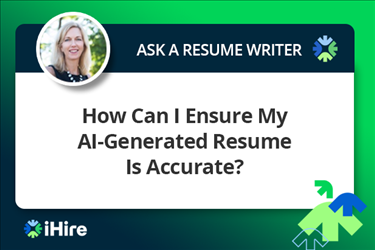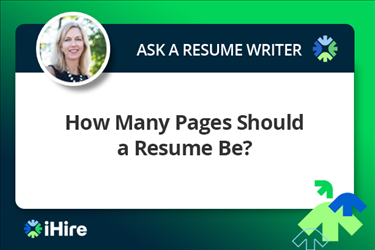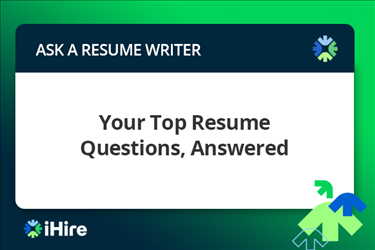- Job Seeker Resources
- |
- Last Updated: February 08, 2023

5 Must-Read Commercial Artist Resume Tips
Searching for commercial art jobs? Looking to take the next step in your commercial art career? Check out these artist resume tips to make sure your document is up to par.
Start strong.
Does your resume still have an objective statement at the top? Something along the lines of, “Looking to bring my graphic design skills to a progressive company”? Objective statements are extremely outdated (and not in a cool, vintage way). Your resume should start with a compelling summary paragraph that tells readers why they should hire YOU and not the next candidate.
Example artist resume summary section:
Innovative and progress-oriented professional with extensive experience producing award-winning designs for marketing and advertising campaigns. Combine creative prowess with strong business acumen to accurately translate objectives and consistently deliver top-quality materials that exceed expectations and achieve outstanding results. Demonstrated strengths in overseeing concurrent projects, collaborating effectively with staff of all levels, and implementing process improvements that save costs and resources.
Following your summary paragraph, compile a key skills section with your areas of expertise. Commercial artist resumes aren’t exempt from applicant tracking systems, especially if you’re applying for a job at a big company. This section will help you pass the initial HR screening process while providing a nice visual display of your core abilities.
Example artist resume keywords section:
Multimedia Design · Campaign Direction · Concept Development · Brand Management
Commercial Photography · Resource Allocation · B2B & B2C Marketing
Client & Vendor Relations · Staff Training & Leadership · QA/QC · Production Planning
Show your stuff…
Don’t search the web for artist resume templates or artist resume samples – show off your document design skills and develop a one-of-a-kind resume that expresses your talent and brand. All resumes should have strong content and clearly convey a candidate’s experience, knowledge, and abilities. A commercial artist’s resume, however, will also be heavily judged on its appearance. Use your resume as an opportunity to showcase your creativity.
…but have multiple resume formats prepared and don’t go overboard.
Strive for the right balance between compelling content and compelling design. An over-the-top resume design that’s impossible to read, riddled with typos, or full of bland, cookie-cutter language won’t help you. Furthermore, you’ll likely run into applicant tracking systems that can’t properly convert your amazingly designed document. Have a simplified version or plain text file ready when needed.
Find your next great opportunity. Register with iHireCommercialArt.
Link to your online portfolio.
The design of your resume will speak to your talents, but you should also make it easy for potential employers to find your body of work online. Have an active link to your portfolio on your resume. You may also be able to include examples of your work within the resume itself, such as logo designs or other elements that can be displayed effectively on smaller scale.
Include quantified achievements.
Your portfolio will do the heavy lifting in terms of demonstrating your artistic abilities, but be sure to use your resume to tell the rest of the story. List accomplishments and their measurable outcomes. If you think commercial art achievements are impossible to quantify, think again:
- By how much did sales increase from the marketing brochure you designed?
- How many advertising awards did your email campaign win?
- How many conversions did your website modal deliver?
- How much new business did you bring in by consistently exceeding clients’ expectations?
Also consider contributions you’ve made outside of design work:
- How much time have you saved your team members by setting up an image library?
- How much money have you saved through effective negotiations with vendors?
- By how much did efficiency increase after your company started using a new software program that you recommended?
- How much faster are projects completed with new workflows that you developed?
Follow these tips to get your resume in great shape for your commercial art job search. Looking for extra resume writing help? Check out a commercial art resume sample created by iHire’s team of certified resume writers.

Originally Published: September 29, 2016
Sign In or Register to access all articles and insider tips for help in your job search.
Search for Commercial Art Jobs
RELATED JOBS
By joining Sedgwick, you'll be part of something truly meaningful. Its what our 33,000...
Desktop Publisher Specialist (508 Compliance) (Hybrid) - 3305235Job Title: Desktop Publisher Specialist (508 Compliance) (Hybrid) Type of Position: This...
Graphic Designer - Marketing Results, LTD.URGENTLY HIRING Job Details Company: Marketing Results, LTD. Job Type: Full-time Education:...
Logo DesignerLogo Designer compensation: $100 We're seeking a creative and skilled logo designer to craft a...
Lead Product Designer - Zoom WhiteboardWhat you can expectWere searching for an exceptional Senior Product Designer with a deep passion...
RELATED RESOURCES
Find the Right Job Faster
- Get personalized job matches sent to your inbox every day
- Connect directly with employers before your competition
- Advance your career with expert advice on interviewing, salary negotiation, and more
We value your privacy




